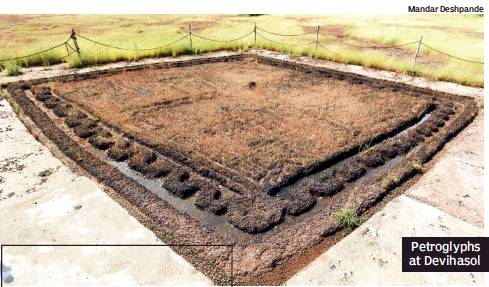Konkan: Petroglyphs
This is a collection of articles archived for the excellence of their content. |
Petroglyphs in 5 villages

From: Shiladitya Pandit, Pandavas, prehistoric man or aliens – who carved these rocks?, October 15, 2018: The Times of India
Efforts are on to unlock the secrets of the shapes engraved in stone across 52 hamlets of Maharashtra
An hour’s drive from Ratnagiri in Maharashtra’s Konkan region, Devihasol is a hamlet in the middle of nowhere. A 12th century Durga temple and an ancient tank are all there is to it, besides a curious structure guarded by bollards and chains. Mahesh Sakpal, who has come to attend the annual Durga festival from a village nearby, is eager to tell visitors about it. “You see that stone in the middle, that is where the Devi comes and sits during the festival. The locals worship her for ten days, and then she goes. No one touches or disturbs her. We have built these guards so no one damages the spot. Our ancestors have said that it is from the time of the Pandavas,” says Sakpal.
The stone in question is a petroglyph, a square engraved into ancient rock on the ground, lined with wavy, snakelike forms. In a smaller concentric square are abstract markings in perfect grids.
These petroglyphs have now been found in 52 villages across 150km in the area. Many feature human figures, both life size and larger, and animals that include non-natives like the extinct elephant bird and the rhino.
Little is known about the people who carved them, though archeologists are ascribing it to an ancient, previously unknown civilisation.
Some of them were always there in plain sight and revered by locals as imagery from the epics. Others have been discovered by local explorers, researchers and the state archaeological department.
Sudhir Risbud, an electrical engineer in Ratnagiri, discovered 22 of these sites during cycling tours with his friend Manoj Marathe over almost 10 years. “We travelled nearly 10,000km in the region, and started an organisation to spread awareness and to gain more information about the sites,” he says.
Although venerated by locals, a few sites have been damaged. One of them is in Nivali village on the way to Ganpatipule town, off NH-66. The exposed rock shows some abstract, curvilinear lines but nothing much is decipherable. Arvind Suryavanshi, headmaster of the Panchasheel High School nearby, laments: “Part of the site was destroyed when the government built the road to Ganpatipule. Two years back, they tried to widen the road, which would have completely destroyed the petroglyph. The locals protested and the proposal did not come up again.”
Sudhir Jadhav works in Mumbai for the foundation that runs the high school, but grew up in Gonyacha Kata village, site of another petroglyph — bean-shaped, with stripes, and another, more circular carving right next to it. “These have always been there. Folklore has it that these are markings made by Pandavas when they were living in forests nearby. These are also seen as images of the sun,” he says.
In Mashebav village, human and animal forms dominate a rocky expanse of land a few metres from the local temple, itself hundreds of years old. A reservoir nearby is used for immersions. Vikas Dhanawade, owner of the village eatery, says there are images on rocks below the reservoir as well. “You can see them in the drier months. They are mostly of animals; we were shown these images as children as a warning not to harm animals. And that has been the case ever since,” he laughs. Across a small stream, the carving of a human figure emerges from the ground, complete with nose, limbs, even rib cage.
Could these be the handiwork of a prehistoric civilisation? Shrikant Pradhan, a professor at Deccan College in Pune, says some people in the area even see them as the handiwork of aliens as some of these images are “properly perceptible only from a certain height”. Pradhan has been researching the petroglyphs for nearly a decade. “What we can say from the data gathered till now is that these carvings are from the prehistoric to the early historic period. To prove that it might have been a part of a lost civilisation, we have to find a lot of other things, like stone tools, besides more of these sites. We can also gather that it was definitely not a farming society, but seeing the kind of curvilinear lines on the rocks, there was some advancement in thinking. The lines are abstract, but they are in some form, and there is a particular pattern among a lot of them,” he observes.
Tejas Garge, state director of archaeology and museums, says the state government has been covering the department’s excavation and research costs at these sites, though there has been no formal allotment of funds. “We have requested for a grant of Rs 1.4 crore to preserve these sites better, and to enhance their tourism potential in collaboration with the Ratnagiri district administration,” he says.